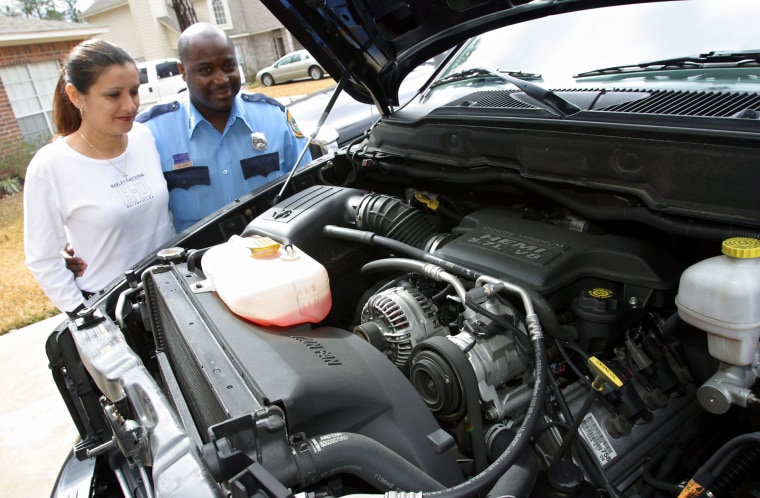Americans are renewing their love affair with heightened horsepower.
At auto dealers across the country, a growing number of buyers are trading up to SUVs and trucks powered by big engines such as V-8s and Hemis, machines once shunned as gas-guzzling polluters but now increasingly embraced for their might.
Carlton Jack of The Woodlands, Texas, was so enamored by his Dodge Ram pickup powered by a Hemi that he bought another for his wife, Lourdes, at Christmas.
“Fuel consumption wasn’t a consideration,” said Jack, a Houston policeman and former Ford truck owner. “I wanted the power and performance of the Hemi, and I liked the looks of the Ram. That’s what sold me.”
Automakers installed large V-8 engines in 29.1 percent of all passenger vehicles built in North America for the U.S. market last year, the highest rate since 1985, according to Ward’s Automotive Reports. The rate has risen every year since 2000, when V-8s went into 25.3 percent of North American-built cars and trucks for American drivers, Ward’s statistics show.
In the same four-year stretch, smaller 4-cylinder installations fell from nearly 27 percent to 25.3 percent.
Old technology, new again
Analysts and industry executives give a variety of reasons for the rise in V-8s, which use more fuel but produce more power than smaller engines: strong demand for trucks and sport utility vehicles, relatively inexpensive gas prices, and technology that’s leading to improved fuel efficiency, even in bigger engines.
The popular Hemi, which dates to the 1950s, gets its name from the hemispherical shape of its combustion chamber, which Chrysler executives say allows it to produce more power and achieve greater fuel economy. Chrysler introduced the newest version of the Hemi in 2002 on heavy-duty trucks, then began offering it as an option on the Dodge Ram 1500 pickup and Durango SUV.
Chrysler says a Hemi-equipped 2004 Ram 1500 can get 14 miles per gallon in the city and 18 mpg on the highway, roughly 10 percent better than the non-Hemi engine in the previous Ram.
Environmental advocates say making vehicles more powerful is the wrong approach — Detroit automakers should be focusing instead on hybrid and other “green” technology that foreign makers excel at.
“There will always be a market for the gas-guzzling powerhouse, but the American manufacturer seems to be willing to lose market share as Toyota and Honda bring in better technology,” said Daniel Becker, director of the global warming and energy project for the Sierra Club. “It’s unfortunate that Detroit confuses horsepower with quality, and it’s why more and more Americans are buying imported vehicles.”
But foreign makers are also interested in the bigger engines.
Nissan Motor Co., for example, which made its name in the domestic market selling small, fuel-efficient cars, recently launched the full-size Titan pickup with a hefty V-8 engine to challenge the Dodge Ram and models from Ford, Chevrolet and GMC. Nissan also added a bigger engine and more horsepower to its latest Altima sedan.
Lee Weinman, a Ford dealer in Chicago, said the fact that major automakers are beefing up engines at the same time they’re spending billions on hybrids and fuel-cell technology speaks to the increasingly diverse tastes of American drivers.
Many more consumers also are opting for the ecologically friendly gasoline-electric hybrid vehicles. For now, the only hybrids available in the United States are small cars made by Honda Motor Co. and Toyota Motor Corp., yet sales have risen from about 20,000 in 2001 to 47,000 last year, according to the Power Information Network, an affiliate of J.D. Power and Associates.
“There definitely seems to be a trend of buyers looking for more power, but a successful manufacturer pretty much has to have a wide offering to remain viable,” Weinman said.
Captivated by cash back
Incentives help, too. Many buyers are using cash rebates or low interest rates to help them nab vehicles with larger, more expensive engines.
More than 50 percent of those choosing new Ram 1500s and Durangos are opting for the more expensive Hemi versions — double the anticipated “take rate,” Chrysler officials said.
Chrysler also will offer the Hemi on two upcoming cars, the Chrysler 300C sedan and Dodge Magnum sport wagon. The car-version of the Hemi has an added feature — a so-called multi-displacement system — that allows the vehicle to reduce the number of cylinders in use during normal driving conditions, improving fuel economy an extra 10 percent to 20 percent.
“We have a few other applications you’ll see coming out over the next few months,” said Eric Ridenour, Chrysler’s executive vice president for product development, who declined to provide specifics. “You’ll see (the Hemi) across a whole range of vehicles.”
